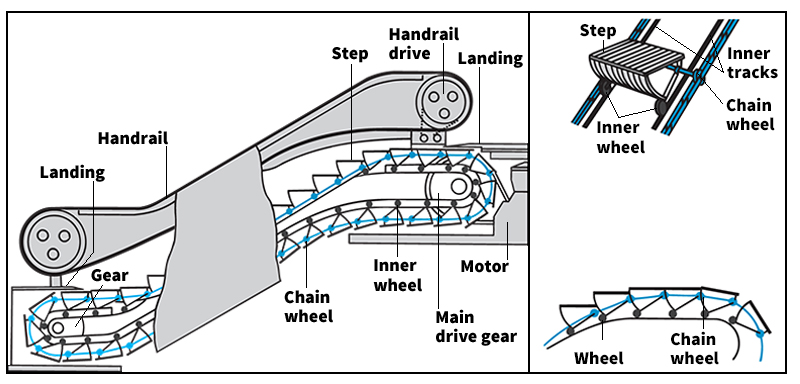Escalator is a moving stairway that transports people from one floor or level to another. Escalators are found in airports, subway stations, stores, and other commercial and public buildings. Moving sidewalks are similar to escalators but operate on flat or slightly inclined surfaces.

An escalator resembles a conveyor belt with steps attached. Each step has two pairs of wheels on the underside. The wheels travel on two sets of tracks. The steps are pulled along the tracks by chains that move around gears at the top and bottom of the escalator. An electric motor powers the steps. The steps of an escalator are formed where the two sets of tracks run alongside each other. At the top and bottom of an escalator, the two sets of tracks level off and separate, causing the steps to flatten. The steps form a moving platform that enables passengers to get on or off at the landing without tripping. Other safety features include moving handrails and a grooved tread on the steps. Safety devices stop an escalator if anything gets caught in the steps.
Escalators can move at two speeds—90 or 120 feet (27 or 37 meters) per minute. Stores generally use the slower speed so that passengers have time to look at the merchandise on each floor. Escalators in airports and subways use the faster speed. Some escalators can carry up to 4,500 people an hour. The movement of the steps can be reversed during rush hours, when most traffic moves in one direction. Modern escalators have sensors and can slow down to save energy when no people are nearby.
The escalator developed chiefly from the work of two American inventors, George H. Wheeler and Jesse W. Reno. In 1892, Wheeler patented a design for a moving stairway that had flat steps and landings at the sides. He later sold the patent to another inventor, who improved the design. Reno developed an inclined conveyor belt with a grooved tread for steady footing. The first operating escalator, based on Reno’s design, was used in a New York City elevated train station in 1900. In 1922, the Otis Elevator Company combined the flat steps and the grooved tread to form the modern escalator.
